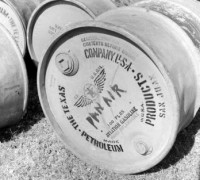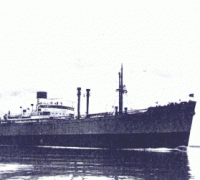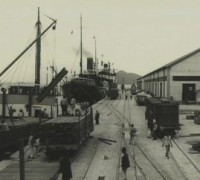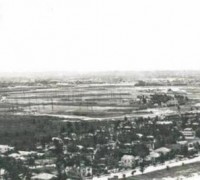COMMANDER SOUTH ATLANTIC FORCE AT RECIFE - COMMANDER SOUTH ATLANTIC
14)SECRETARY KNOX FIRST VISIT
The Ericsson and Eberle, Destroyers, reported for duty to the Commander Task Force Twenty Three on September 10, while at Trinidad. The Ericsson came straight to Base Fox; the Eberle remained for awhile at Base Dog (Trinidad) to go submarine hunting with the Davis, also there at the tie. For this operation, the two ships acted temporarily under the Commander Caribbean Sea Frontier. While cruising together, the Davis and Eberle made several submarine contacts on September 16 and 17.
On the 15th they had proceeded out of the Gulf of Paria after a submarine, perhaps more than one, that was reported in the Trinidad - Tobago area. They cleared Boca de Navios and then traveled on course 300° for 32 miles, after which they went southeastward through the channel between Trinidad and the Tobagos. They spent the night hunting to the east and northeast of Trinidad. Just before noon the following day, a PBY plane reported to them of having seen and attacked a surfaced submarine in 11° 05' N, 60° 15' W. With all possible despatch the Davis and Eberle proceeded to the area named, where they sighted the plane circling overhead. This was at about 1300. As they proceeded southward toward the PBY, the sub's coning tower could be seen dead ahead, about 16,000 yards distant. The enemy had submerged by the time the ships reached the vicinity, but the plane dropped a smoke float at the point of disappearance, and they commenced an unsuccessful sound search.
At 1540 a retiring search was started, using an assumed submarine speed of 3 knots from the place of submergence. The Eberle then attempted unsuccessfully, to gain contact, after which the Davis tried it again with failure. Another retiring search followed and was rewarded by another contact, made by the Davis at 1750. The ship attacked again, and then the Eberle, following which a line of air bubbles was seen leaving the depth charged area. A temporary injury to the Davis' sound gear delayed things, but a third attack was delivered at 1805. Nothing that could be observed gave reason to believe the submarine destroyed or badly damaged.
The following day, late in the evening, the Davis and Eberle, while forming part of a Hunting Group which included the Destroyers Quick, Beatty, and Mervine, made another submarine contact. This time, however, radar equipment was either in poor shape, or was not being used, as the first intimation of the sub was sighting by the deck officer of the Davis. The enemy craft lay about 500 yards directly ahead of the Eberle. The Davis reported its presence to the other ships and opened fire with the guns of her Ready Mount. The Eberle, which was close on the submarine at the moment of sighting, passed the enemy and as she did so fired depth charges from the projectors. Other ships had meanwhile seized the opportunity to get in a few shots. Orders had been given to the Eberle to ram the sub, but due to circumstances impossible to ascertain at present, she did not do so. The submarine disappeared, and the opinion was that as a result of the gunnery and depth charges she could be scored a kill. Nevertheless there remained some doubt.
During the remainder of the month, several more attacks by the ships on submarines took place, all with results estimated as negative. On the 23rd, two Army planes from Ascension sighted a sub about fifteen miles northwest of the island and attacked at once. The two 350 pound depth charges dropped landed close to the enemy, and the pilots stated that they believed damage to have been inflicted, though without claiming a kill.
In addition to the Ericsson, which was soon detached, and the Eberle, the ships reporting for duty in September, wee the two PCs, 544 and 547, and the Destroyers Belknap, George E. Badger, and Ellis. The PCs came merely for transfer to the Brazilian Navy, and on September 24, the ceremony took place at Natal. Presentation was made by the ships' American Commanders, Lieutenants A. G. Cook and S. P. Johnson. Rear Admiral Ary Parreiras, Chief of the Commission of the Naval Base of Natal, received them on behalf of Brazil. The Brazilian crews boarded immediately and raised their colors, while the American seamen were transferred to other ships for temporary duty except those needed in key positions to instruct the Brazilians. Needless to say, the ships were immediately renamed, the PC-544 becoming the Guaporé, while the new name of the 547 was Gurupi. The two ships in their altered status, continued to serve under the Admiral's command, as did the entire Brazilian Navy. The day following their transfer they became Task Group Cast, operating under Commander Cox, a Brazilian Officer with an Anglo-Saxon name.
On September 27, Admiral Ingram left Recife for Natal to meet the Secretary of the Navy, Colonel Frank Knox. The purpose was to escort him from there to Rio, for a conference with President Vargas and Brazilian officials. Secretary Knox arrived by plane on the 28th and spent the night in Natal in the very primitive accommodations the Naval Facilities could afford. The following day they went on to Rio, arriving late in the afternoon and meeting with a popular reception.
President Vargas sent for the Admiral at once and the interview on this occasion was almost as momentous as their first meeting at Poços de Caldas in April. The president stated that his Armed Services were not capable of working in unison, and he therefore proposed to put all three branches under the American Admiral's operational control for the defense of Brazil. This would involve any operations, offensive or defensive, that might be necessary for the protection of the coast and coastal cities. It was a great responsibility to assume, but the Admiral accepted it and reported having done so to Colonel Knox that evening. The Secretary's reaction to this was violently unfavorable. No self respecting country, he said, could in sincerity take the step Brazil had taken; therefore the latter could not mean business. In accepting, the Admiral had made himself, as the Secretary put it, a "stooge".
Some rather heated conversation followed, during which Admiral Ingram stated that if his actions were not approved he should be relieved of his command at once. This was necessary, he said, since a conference had already been held with the Chiefs of the three Brazilian Services and preliminary plans mapped out for joint operation. If the plans could not go through, then, in all fairness the Brazilians should be told that a change was in prospect. The Secretary did not propose to do anything so radical, but remained dissatisfied. Since it was necessary for the Admiral to return to his Recife Headquarters to get on with the war, he left the Secretary in Rio and flew back. The matter of appeasing Colonel Knox and of explaining the Brazilian viewpoint to him devolved to Ambassador Caffery. A few days later, the Secretary passed through Recife on his way home and seemed somewhat mollified.
HyperWar Commander South Atlantic Force. U.S. Naval Administration in WW II



